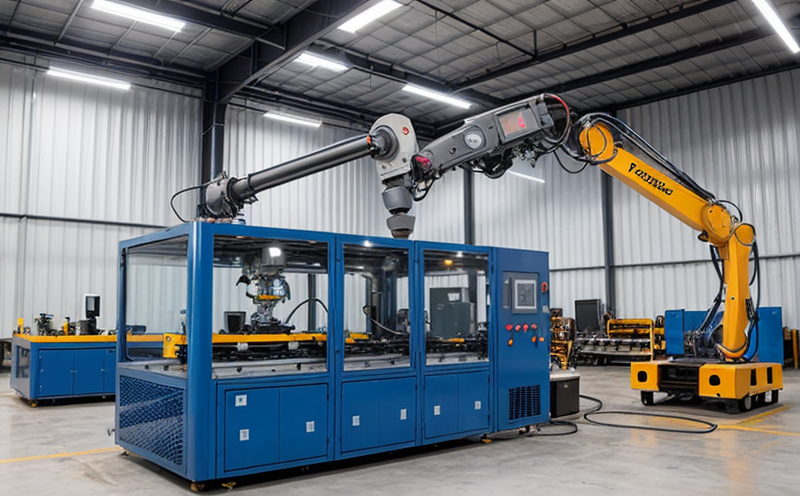ISO 16750 Environmental Testing of Robotics Electronics
The International Organization for Standardization (ISO) has established ISO 16750 as a set of standards aimed at ensuring the durability and reliability of automotive electronics, including those used in robotics systems. This testing is crucial to ensure that electronic components within industrial robotic systems can withstand environmental stresses without compromising performance or safety.
The scope of ISO 16750 encompasses several key aspects relevant to the testing of robotics and automation systems. It covers a wide range of environments, including temperature cycling, humidity exposure, salt fog, dust ingress, vibration, shock, and more. Each test focuses on specific parameters that can affect the longevity and reliability of electronics in industrial applications.
The process begins with detailed specimen preparation, ensuring that each component is representative of the final product. This involves cleaning, drying, and preparing the electronics for exposure to environmental conditions. Once prepared, the specimens are subjected to various environmental challenges designed to simulate real-world scenarios encountered by industrial robots.
During testing, the performance of the electronic components is monitored closely using state-of-the-art instrumentation. This includes measuring electrical resistance changes, checking functionality under stress, and verifying that no damage has occurred due to exposure. The results are meticulously recorded and analyzed against established acceptance criteria defined in ISO 16750.
Testing according to this standard ensures compliance with international regulations and helps manufacturers meet the rigorous demands of automotive and industrial sectors. It also supports ongoing improvements in design, ensuring that robotics systems can operate safely and efficiently under harsh conditions. By adhering to these standards, companies not only enhance product quality but also contribute positively to industry best practices.
The scope of ISO 16750 is broad enough to cover various types of industrial robots used across different manufacturing processes. Whether it’s welding, painting, assembly, or material handling tasks, the environmental stressors faced by these systems are consistent. Therefore, this testing protocol provides a comprehensive framework for assessing how well robotic electronics perform under challenging conditions.
For quality managers and compliance officers responsible for ensuring product reliability, ISO 16750 offers a robust approach to validating the robustness of robotics components. R&D engineers find it invaluable as they refine designs aimed at increasing resistance against environmental factors. Similarly, procurement teams benefit from knowing that suppliers meet stringent testing criteria before integrating parts into their products.
Industry Applications
The application of ISO 16750 in industrial manufacturing and processing is extensive. It plays a critical role in several key areas within the industry, ensuring that robotics systems operate reliably across diverse environments:
- Automotive Manufacturing: Ensuring safety-critical components like sensors and controllers can withstand factory floor conditions.
- Pharmaceuticals: Guaranteeing precision equipment remains functional in cleanroom settings despite potential dust or humidity issues.
- Food Processing: Maintaining hygiene standards by validating that robotic arms used in packaging remain unaffected by contaminants like grease or water.
The versatility of this testing ensures it can be adapted to various industries where automation and robotics are integral, thereby enhancing overall productivity and safety.
Why Choose This Test
- Promotes Compliance: Ensures adherence to international standards recognized globally.
- Enhances Reliability: Identifies potential weaknesses early in the development cycle, allowing for necessary improvements before mass production begins.
- Cost-Effective: Reduces costs associated with post-market recalls and repairs by identifying issues during R&D stages.
- Customer Satisfaction: Builds trust through consistent quality assurance processes aligned with customer expectations.
The ISO 16750 test provides peace of mind knowing that your robotics systems meet the highest standards, thereby reducing risks associated with subpar performance or failures in critical environments.
Competitive Advantage and Market Impact
- Innovation Leadership: By staying ahead of regulatory changes and industry trends, companies gain a competitive edge over competitors who may lag behind in adopting new testing protocols.
- Brand Reputation: Adhering to ISO 16750 enhances brand reputation by demonstrating commitment to excellence in product development and quality assurance.
- Sales Growth: Meeting these standards opens doors to international markets where stringent environmental requirements are enforced.
- Premium Pricing Power: Demonstrating adherence to such rigorous testing allows for premium pricing strategies without compromising on value-added features.
The impact of ISO 16750 extends beyond individual companies; it contributes positively towards the overall advancement of robotics technology, fostering innovation and reliability across sectors.





